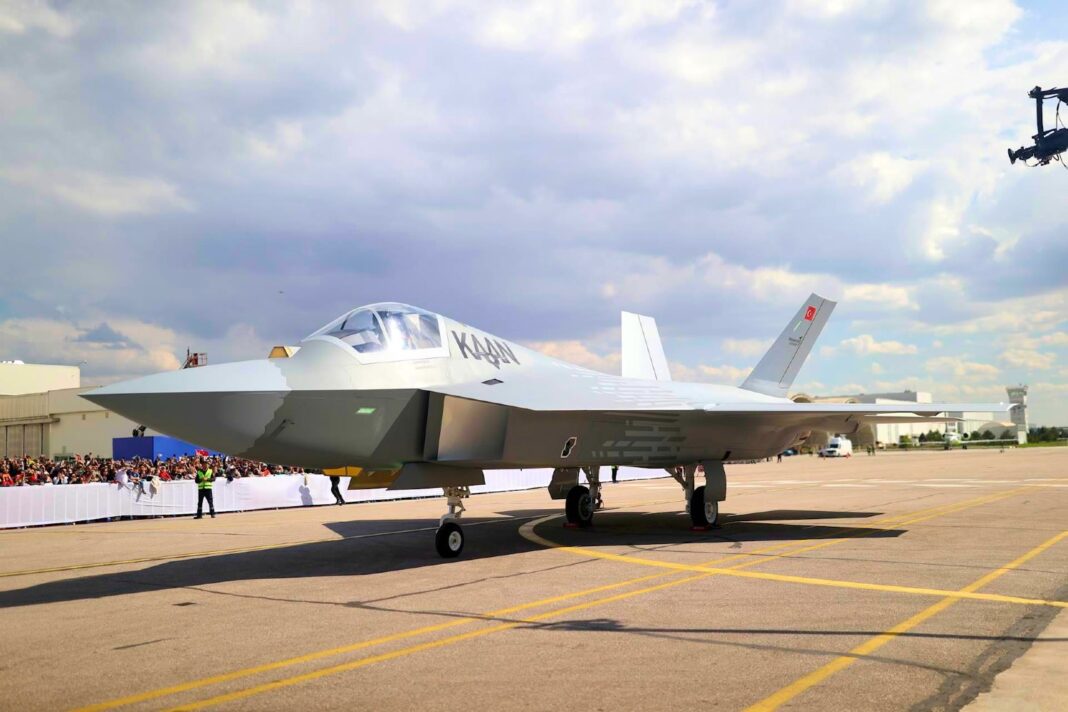Speculations about Pakistan joining Turkey’s homegrown fifth-generation fighter jet program “Kaan” are gathering steam, days after the CEO of Turkish Aerospace Industries (TAI) announced that it will begin flights in December this year.
Some reports and social media posts published by Pakistani military bloggers have asserted that the country is on the verge of signing a contract to join the ‘Kaan’ stealth fighter jet project with another Turkish ally, Azerbaijan. Neither Turkey nor Pakistan have confirmed these reports.
These speculations started swirling on the social networking site ‘X’ in late July and have become more prominent. According to some sections in Pakistan, the three countries have allegedly signed a Memorandum of Understanding (MoU) to cooperate on developing the fifth-generation fighter jet.
An X social media account named ‘Air Operations Syndicate,’ known for reporting on Pakistan military aviation, said: “Pakistan all set to join Turkish 5th Generation Fighter Program as an official partner. Previously, the partnership was restricted to technical assistance only. This development means more jobs for Pakistani engineers and more technology transfer for our aviation industry.”
The post was accompanied by a video of the Deputy Minister of Defense of Turkey, Dr. Celal Sami Tüfekci, saying that his country would talk with his Pakistani counterparts to discuss the latter’s entry into the Turkish national fighter jet program “Kaan.” Pakistan has not stated its official position on the matter yet.
These reports, however, come more than a year after the Turkish Defense Industry Committee head Ismail Demir said in an interview with CNN Turk: “Our doors are open for cooperation in this direction. In particular, we are talking about cooperation with countries such as Azerbaijan and Pakistan, and we propose to unite efforts in this direction.”
EurAsian Times reached out to a few informed sources in Pakistan. A Pakistani journalist told EurAsian Times on the condition of anonymity that “Turkish Aerospace is the designer and manufacturer of Kaan and serval other aircraft and drones (ANKA drone). Turkish Aerospace established its office in Islamabad a couple of years ago. They are hiring many Pakistani engineers, offering them jobs, internships, etc. There is every possibility that Pakistan is part of this program or is soon going to be.”
When probed further on why Pakistan hasn’t accepted it publicly, the source added, “Well, things are very different in Pakistan compared to its neighbor India or other countries. The Pakistani government is unlikely to acknowledge these agreements or deals unless the system is delivered.”
Citing an example to support his argument surrounding Pakistan’s reluctance to announce big-ticket defense deals, the source said, “We procured J-10C from China, but before the arrival of aircraft, no one from government & air force officially acknowledged it. Only after the aircraft touched down in Pakistan sporting the colors of the country’s flag is when it was finally confirmed. Military bloggers, however, spill the beans on social media occasionally.”
The rumors surrounding Pakistan’s participation in the program have been around for a long time. The EurAsian Times had reported in February 2022 that TAI General Manager Temel Kotil slipped in an interview that Turkey and Pakistan were working together on a fifth-generation fighter. At the time, however, it wasn’t known whether Turkey would cooperate with Pakistan on the same project or build another fifth-generation fighter.
Pakistan Air Force Air Vice Marshal Rizwan Riaz, serving as the pro-rector for research, innovation, and commercialization at the National University of Sciences and Technology (NUST), the country’s top scientific institution, said, “This is a fifth-generation fighter aircraft on which Pakistan and Turkey are now cooperating.”
Turkey’s Kaan Fighter Jet Ready For The Skies
The development comes after TAI General Manager Temel Kotil announced on television late last month that the company had chosen December 27 for the aircraft’s debut into Turkish skies, five years before schedule.
With its alacrity for cooperation, Pakistan and Azerbaijan are believed to be the two most obvious choices to collaborate, given Turkey’s close defense ties with the two countries. Moreover, the three countries have forged regional and military relations among themselves. Pakistan and Turkey provided military support to Azerbaijan during the 44+ days-long Second Karabakh War in September 2020.
Turkey and Pakistan are close allies and have solid military cooperation. Kotil has referred to his fifth-generation fighter as the “first big fighter” of the Muslim world, which is the most robust basis of its allyship with Pakistan.
When asked whether Pakistan had shelved its fifth-generation fighter jet program called ‘Project Azam,’ the source told EurAsian Times: “There is no information regarding any work by Pakistan on Project Azam,” without confirming whether the project was now off the table.
However, there hasn’t been any official development on Pakistan’s Azam project reported in years. This is perhaps where the Turkish fifth-generation fighter project comes into the picture, especially since Pakistan’s arch-rival and main adversary, India, is earnestly working on its fifth-generation aircraft AMCA.

The Turkish Air Forces Command was supposed to receive the fighter jets from TAI by 2028, even though the Kaan project kickstarted in 2016. However, the aircraft is already on its way to make the first flight and delivered ahead of schedule.
The two engines on the 21-meter (about 69-foot) aircraft, each of which is capable of producing 29,000 pounds (13,000 kilograms) of thrust, enable it to travel at a top speed of Mach 1.8 (2,222 kph).
Kaan’s features include high situational awareness, reduced pilot workload, combat damage detection, next-generation mission systems, minimal observability, precision strikes, and an internal weapons bay.
The fifth-generation fighter jet was initially envisioned as a replacement for Turkey’s F-16 Fighting Falcons. Pakistan, on its part, also operates the F-16s along with some other 4th and 4.5th generation combat planes acquired from the West and China over the years.
eurasiatimes-BySakshi Tiwari

